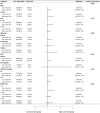Association between excessive screen time and falls, with additional risk from insufficient sleep duration in children and adolescents, a large cross-sectional study in China
- PMID: 39712319
- PMCID: PMC11659216
- DOI: 10.3389/fpubh.2024.1452133
Association between excessive screen time and falls, with additional risk from insufficient sleep duration in children and adolescents, a large cross-sectional study in China
Abstract
Objective: Falls is a major global public health issue that occur in all age groups. However, the association between screen time, sleep duration and falls in children and adolescents remains unclear.
Methods: This study included children and adolescents who participated in the 2017 Nutrition and Health Surveillance of Children and Lactating Mothers in China. Screen time, sleep duration and falls in the past 12 months were assessed using baseline questionnaires completed by the participants. We utilized a multivariate logistic regression model to estimate the association between screen time, sleep duration, and falls in children and adolescents. Stratified analyses and sensitivity analyses were performed using the same modelling strategies.
Results: A total of 564 participants (5.7%) self-reported falls in the past 12 months. Multivariate logistic regression analysis revealed that high screen time (> 2 h per day) was associated with a higher incidence of falls (cOR:1.46, 95% CI: 1.22-1.74, p < 0.001). The combination of high screen time and low sleep duration was associated with an increased risk of falls compared to the recommended low screen time and high sleep duration group (cOR: 1.62, 95% CI: 1.25-2.09, p < 0.001). After adjusting for relevant covariates, the associations remained significant (aOR: 1.30, 95% CI: 1.08-1.56, p = 0.006; aOR: 1.43, 95% CI: 1.10-1.87, p = 0.008).
Conclusion: Our study demonstrates that both high screen time and the combination of high screen time and low sleep duration were associated with an increased risk of falls. Interventions to promote healthy physical development should commence in early childhood to decrease the incidence of fall injuries in children and adolescents.
Keywords: Nutrition and Health Surveillance of Children and Lactating Mothers; adolescents; children; falls; screen time; sleep duration.
Copyright © 2024 Zhang, Zhu, Xiao, Wu, Jin, Liu, Liu, Cui and Dong.
Conflict of interest statement
The authors declare that the research was conducted in the absence of any commercial or financial relationships that could be construed as a potential conflict of interest.
Figures



Similar articles
-
Cultural Approaches to Addressing Sleep Deprivation and Improving Sleep Health in Japan: Sleep Issues Among Children and Adolescents Rooted in Self-Sacrifice and Asceticism.Children (Basel). 2025 Apr 27;12(5):566. doi: 10.3390/children12050566. Children (Basel). 2025. PMID: 40426745 Free PMC article. Review.
-
Associations between body mass index and sleep duration in Brazilian children and adolescents: the moderating role of screen time.J Pediatr Endocrinol Metab. 2025 Feb 14;38(4):326-332. doi: 10.1515/jpem-2024-0302. Print 2025 Apr 28. J Pediatr Endocrinol Metab. 2025. PMID: 39938888
-
The association between excessive screen-time behaviors and insufficient sleep among adolescents: Findings from the 2017 youth risk behavior surveillance system.Psychiatry Res. 2019 Nov;281:112586. doi: 10.1016/j.psychres.2019.112586. Epub 2019 Sep 27. Psychiatry Res. 2019. PMID: 31629305
-
Associations between sleep parameters and falls among older adults with and without cardiovascular disease: Evidence from the China Health and Retirement Longitudinal Study (CHARLS).Geriatr Gerontol Int. 2025 Jan;25(1):38-47. doi: 10.1111/ggi.15034. Epub 2024 Dec 9. Geriatr Gerontol Int. 2025. PMID: 39654315 Free PMC article.
-
Sleep duration and sleep disturbances in association with falls among the middle-aged and older adults in China: a population-based nationwide study.BMC Geriatr. 2018 Aug 28;18(1):196. doi: 10.1186/s12877-018-0889-x. BMC Geriatr. 2018. PMID: 30153791 Free PMC article.
Cited by
-
Cultural Approaches to Addressing Sleep Deprivation and Improving Sleep Health in Japan: Sleep Issues Among Children and Adolescents Rooted in Self-Sacrifice and Asceticism.Children (Basel). 2025 Apr 27;12(5):566. doi: 10.3390/children12050566. Children (Basel). 2025. PMID: 40426745 Free PMC article. Review.
-
Predicting higher risk factors for COVID-19 short-term reinfection in patients with rheumatic diseases: a modeling study based on XGBoost algorithm.J Transl Med. 2024 Dec 24;22(1):1144. doi: 10.1186/s12967-024-05982-2. J Transl Med. 2024. PMID: 39719617 Free PMC article.
References
-
- World Health Organization . Step safely: Strategies for preventing and managing falls across the life-course [internet]. Geneva: World Health Organization; (2021).
-
- Roth GA, Abate D, Abate KH, Abay SM, Abbafati C, Abbasi N, et al. . Global, regional, and national age-sex-specific mortality for 282 causes of death in 195 countries and territories, 1980–2017: a systematic analysis for the global burden of disease study 2017. Lancet. (2018) 392:1736–88. doi: 10.1016/S0140-6736(18)32203-7, PMID: - DOI - PMC - PubMed
-
- Children’s Safety Network The Medical Costs of Childhood Injuries: Hospitalizations. Available at: https://www.childrenssafetynetwork.org/infographics/medical-costs-childh... (Accessed June, 2024).
MeSH terms
LinkOut - more resources
Full Text Sources
Medical
Miscellaneous

